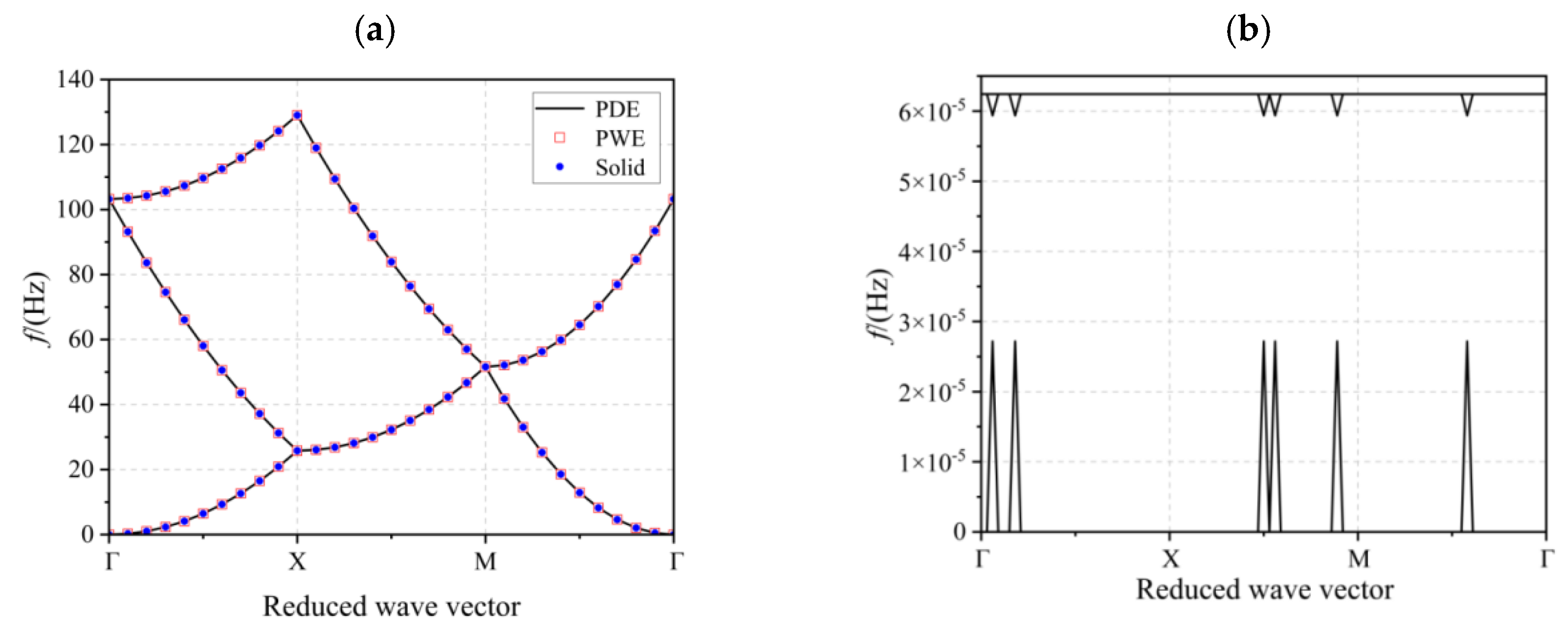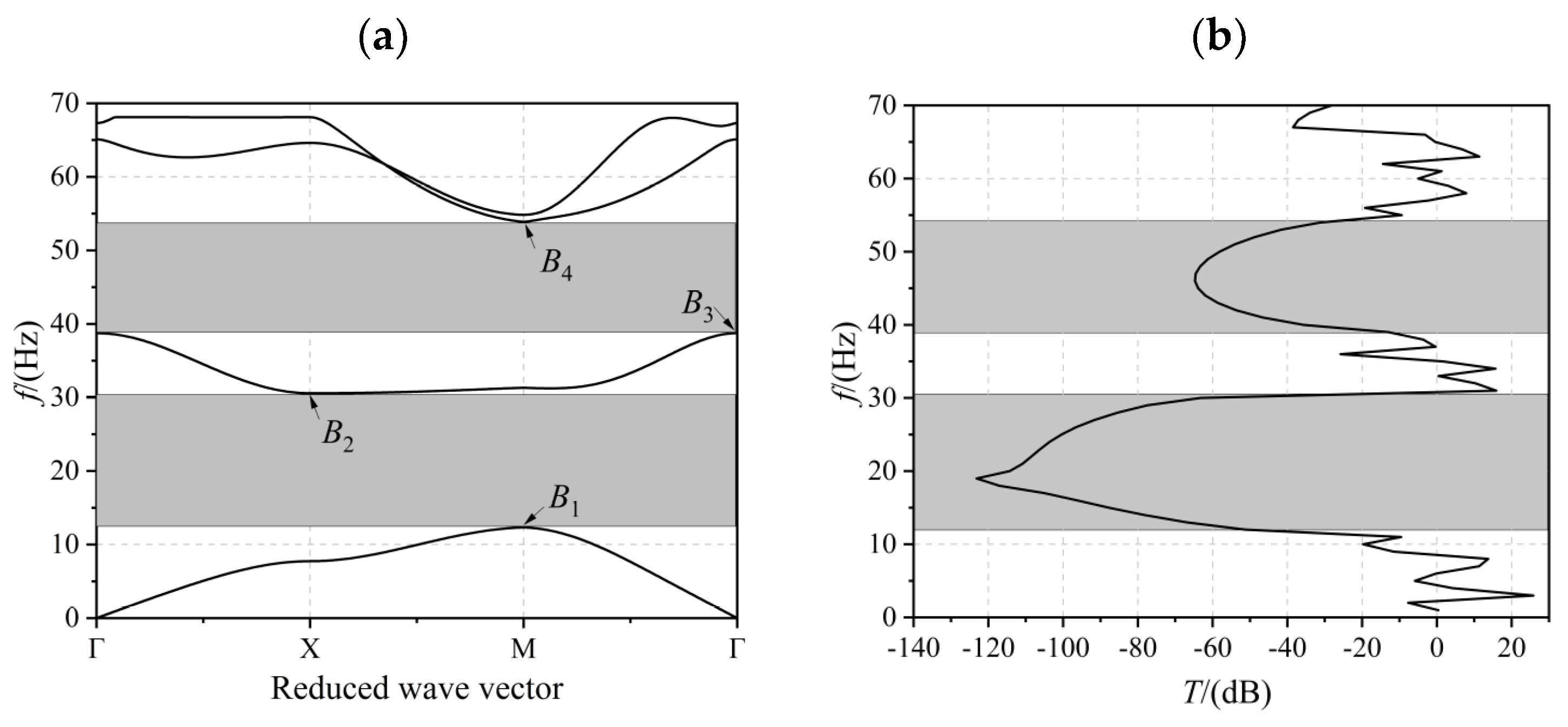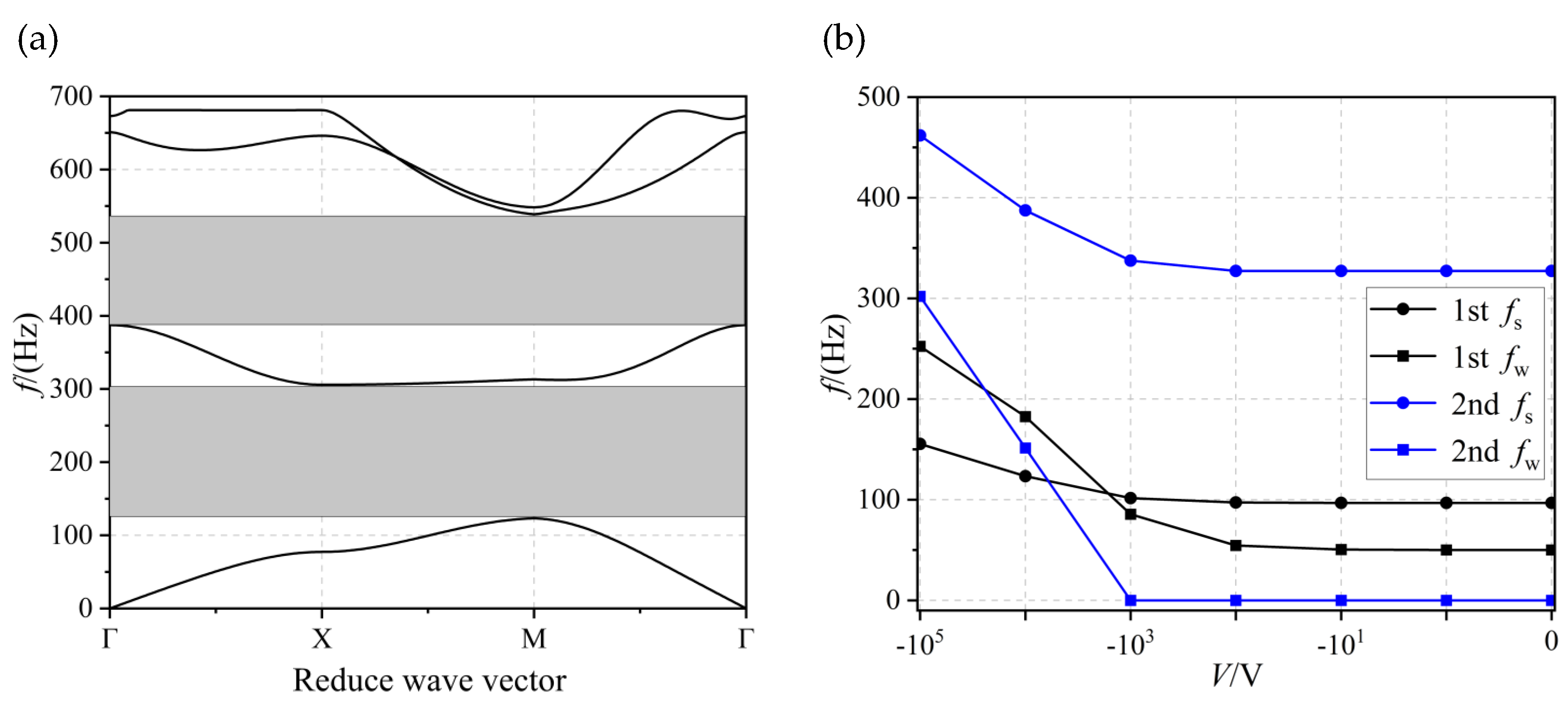Investigation of Bandgap Properties of a Piezoelectric Phononic Crystal Plate Based on the PDE Module in COMSOL
Abstract
:1. Introduction
2. Modelling and Methodology
2.1. Construction of the Model
2.2. Method of Obtaining the Energy Band Structure Diagram Based on the PDE Module
2.3. Method of Obtaining the Transmission Curve Diagram Based on the PDE Module
2.4. Validation Based on the PDE Method
3. Numerical Results and Analysis
3.1. Energy Band Structure
3.2. The Order of Magnitude of Thickness, the Effect of Voltage on the Bandgap, and the Dependence between Them
3.3. Effect of Geometrical Parameters on Bandgap
4. Conclusions
- The simulation results obtained using the method proposed in this paper are in full agreement with those solved using the PWE method and the solid mechanics module in COMSOL6.1, which verifies the feasibility of the method. During the calculations, it was found that the computational speed of the method substantially increased compared to solving it using the solid mechanics module. Compared with the PWE method, this method directly obtained the transmission curve map and the vibration modal map.
- As the thickness unit of the piezoelectric PC sheet structure decreased by one order of magnitude, the frequency band in which the bandgap was located correspondingly decreased by one order of magnitude, and the order of magnitude of the voltage that needed to be applied to change this bandgap decreased. The adhered piezoelectric PC sheet made it easier to control the bandgap by changing the voltage, providing a new reference for engineering applications.
- In practice, the bandgap can be modulated by varying its lattice constant a, the radius r, and the thickness h of the embedded circle.
Author Contributions
Funding
Informed Consent Statement
Data Availability Statement
Conflicts of Interest
References
- Zhou, S.M.; Tang, X.D.; Xie, H. Ship vibration and noise reduction measures and methods. Ship Eng. 2022, 44, 4–10. [Google Scholar]
- Li, W.Z.; Zhang, H.; Li, G.H.; Gao, F. Research on Internal Resonance Phenomenon in Spring Pendulum Based on Mathematica. Phys. Bull. 2022, 4, 33–36. [Google Scholar]
- Guo, X.Y.; Cao, T.Q. Phenomenon of double entropic stochastic resonance with recycled noise. Chin. J. Phys. 2022, 77, 721–732. [Google Scholar] [CrossRef]
- Gao, Y.J.; Xu, S.Y. Review on Complex Flexible Vibration Isolation System. Noise Vib. Control 2011, 31, 27–31. [Google Scholar]
- Zhang, Q.Q.; Zhang, B.; Bai, Y.T.; Wang, L.H. Band gap characteristics of a new type of compound local resonance phononic crystal. Tech. Acoust. 2021, 40, 157–166. [Google Scholar]
- Feng, Q.; Yang, Z.; Guo, W.; Lu, J.; Liang, Y. Research on band gap calculation method of periodic structure based on artificial spring model. Chin. J. Theor. Appl. Mech. 2021, 53, 1684–1697. [Google Scholar]
- Wu, F.; Guo, Z.W.; Wu, J.; Jiang, H.; Du, G. Composite Periodic Structures of Hyperbolic Superstructured Materials Containing a Bandgap modulation and applications. Acta Phys. Sin 2020, 69, 83–94. [Google Scholar] [CrossRef]
- Krushynska, A.O.; Amendola, A.; Bosia, F.; Daraio, C.; Pugno, N.M.; Fraternali, F. Accordion-like metamaterials with tunable ultra-wide low-frequency band gaps. New J. Phys. 2018, 20, 073051. [Google Scholar] [CrossRef]
- Sigalas, M.M.; Economou, E.N. Elastic and acoustic wave band structure. Sound Vib. 1992, 158, 377–382. [Google Scholar] [CrossRef]
- Kushwaha, M.S.; Halevi, P.; Dobrzynski, L.; Djafari-Rouhani, B. Acoustic band structure of periodic elastic composites. Phys. Rev. Lett. 1993, 71, 2022–2025. [Google Scholar] [CrossRef]
- Guo, X.; Guo, H.Y.; Hong, M. Research on vibration and noise reduction of local resonant phononic crystal plate. J. Ship Mech. 2021, 25, 509–516. [Google Scholar]
- Yang, K.; Tang, Y.; Wu, H.L.; Wang, B.H. Research on the low-frequency sound insulation properties of membrane-type local resonant phononic crystals. Ship Sci. Technol. 2022, 44, 26–29. [Google Scholar]
- Zhang, J.; Deng, Y.; Peng, Z.B.; Shi, L.Y. Vibration Reduction Characteristics of Ship Engine Based on Phononic Crystal. J. Chongqing Jiaotong Univ. (Nat. Sci.) 2020, 39, 140–145. [Google Scholar]
- Ruan, Y.D.; Liang, X. Isolating low-frequency vibration from power systems on a ship using spiral phononic crystals. Ocean Eng. 2021, 225, 108804. [Google Scholar] [CrossRef]
- Degraeve, S.; Granger, C.; Dubus, B.; O Vasseur, J.; Thi, M.P.; Hladky, A.-C. Tunability of Bragg band gaps in one-dimensional piezoelectric phononic crystals using external capacitances. Smart Mater. Struct. 2015, 24, 085013. [Google Scholar] [CrossRef]
- Kutsenko, A.A.; Shuvalov, A.L.; Poncelet, O. Dispersion spectrum of acoustoelectric waves in 1D piezoelectric crystal coupled with 2D infinite network of capacitors. J. Appl. Phys. 2018, 123, 044902. [Google Scholar] [CrossRef]
- Dorin, P.; Khan, M.; Wang, K.W. Uncovering and Experimental Realization of Multimodal 3D Topological Metamaterials for Low-Frequency and Multiband Elastic Wave Control. Adv. Sci. 2023, 10, e2304793. [Google Scholar] [CrossRef] [PubMed]
- Dal Poggetto, V.F.; Alberto, L.S. Elastic wave band gaps in a three-dimensional periodic metamaterial using the plane wave expansion method. Int. J. Mech. Sci. 2020, 184, 1–45. [Google Scholar] [CrossRef]
- Chen, M.D.; Wang, N.; Xiao, H. Application of Piezoelectric Materials in Traditional Sound Absorption Structures. Mater. Rep. 2023, 37, 22010070. [Google Scholar]
- Li, Z.Y.; Zheng, Y.Z.; Ma, T.X.; Zhang, C.Z. Smart piezoelectric phononic crystals and metamaterials: State-of-the-art review and outlook. Chin. Sci. Bull. 2022, 67, 1305–1325. [Google Scholar] [CrossRef]
- Wang, Y.; Zhang, C.; Chen, W.; Li, Z.-Y.; Golub, M.V.; Fomenko, S.I. Precise and target-oriented control of the low-frequency Lamb wave bandgaps. J. Sound Vib. 2021, 511, 116367. [Google Scholar] [CrossRef]
- Qian, D.H.; Bao, S.Y.; Shen, F. Studies on thermo-electro-mechanical coupling bandgaps of a piezoelectric phononic crystal nanoplate with surface effects. Int. J. Mod. Phys. B 2019, 33, 1950369. [Google Scholar] [CrossRef]
- Beck, B.S.; Cunefare, K.A.; Ruzzene, M.; Collet, M. Experimental analysis of a cantilever beam with a shunted piezoelectric periodic array. J. Intell. Mater. Syst. Struct. 2011, 22, 1177–1187. [Google Scholar] [CrossRef]
- Chen, L.; Pan, B.Q.; Wang, G. Vibration attention characteristic and band gaps in piezoelectric phononic crystals beam with double local resonant Science. Technol. Eng. 2019, 19, 157–161. [Google Scholar]
- Wang, Z.W.; Zhou, C.P.; Dong, Y. Research on bending vibration characteristics of phononic crystal plates based on Mindlin’s piezoelectric plate theory. Smart Mater. Struct. 2023, 32, 105012. [Google Scholar] [CrossRef]
- Miao, Z.J.; Jiang, R. Complex Band Structure of 2D Piezoelectric Local Resonant Phononic Crystal with Finite Out-Of Plane Extension. Appl. Sci. 2022, 12, 7021. [Google Scholar] [CrossRef]
- Liao, T.; Sun, X.W.; Song, T. Tunable bandgaps in novel two-dimensional piezoelectric phononic crystal slab. Act. Phy. Sin 2018, 67, 229–236. [Google Scholar] [CrossRef]
- Hsu, J.C.; Wu, T.T. Efficient formulation for band-structure calculations of two-dimensional phononic-crystal plates. Phys. Rev. B 2006, 74, 144303. [Google Scholar] [CrossRef]
- Tang, J.; Yang, H.J.; Xu, Q.; Liao, J.W.; Yuan, S.; Hu, Y. Analysis of the transfer characteristics of one-dimensional photonic crystal and its application with transfer matrix method. Infrared Laser Eng. 2010, 39, 76–80. [Google Scholar]
- Tanaka, Y.; Tomoyasu, Y.; Tamura, S. Band structure of acoustic waves in phononic lattices: Two-dimensional composites with large acoustic mismatch. Phys. Rev. B Condens. Matter 2000, 61, 7387. [Google Scholar] [CrossRef]
- Song, X.R.; Song, D.H.; Qi, Y. Studies on calculation method and bandgap properties of a nonlocal piezoelectric phononic crystal nanoplate. Ferroelectrics 2021, 57, 132–144. [Google Scholar] [CrossRef]
- Jin, J.; Hu, N.D.; Hu, H.P. Investigation of size effect on band structure of 2D nano-scale phononic crystal based on nonlocal strain gradient theory. Int. J. Mech. Sci. 2022, 219, 107100. [Google Scholar] [CrossRef]











| Category | PZT-4 | Epoxy |
|---|---|---|
| V | 0 | |
| Parameters of PZT-4 | Value | Parameters of Epoxy | Value |
|---|---|---|---|
| /kg·m−3 | 7500 | /kg·m−3 | 1180 |
| /Gpa | 132 | E/Gpa | 4.35 |
| /Gpa | 71 | 0.368 | |
| /Gpa | 73 | ||
| /Gpa | 115 | ||
| /Gpa | 30.5 | ||
| /C·m−2 | −4.1 | ||
| /C·m−2 | 14.1 | ||
| /CV−1m−1 | 7.124 × 10−9 |
| Parameters | Items |
|---|---|
| ea | |
| da | 0 |
| Γ | |
| f |
| Parameters | Items |
|---|---|
| ea | 0 |
| da | 0 |
| Γ | |
| f | ) |
Disclaimer/Publisher’s Note: The statements, opinions and data contained in all publications are solely those of the individual author(s) and contributor(s) and not of MDPI and/or the editor(s). MDPI and/or the editor(s) disclaim responsibility for any injury to people or property resulting from any ideas, methods, instructions or products referred to in the content. |
© 2024 by the authors. Licensee MDPI, Basel, Switzerland. This article is an open access article distributed under the terms and conditions of the Creative Commons Attribution (CC BY) license (https://creativecommons.org/licenses/by/4.0/).
Share and Cite
Liu, G.; Qian, D. Investigation of Bandgap Properties of a Piezoelectric Phononic Crystal Plate Based on the PDE Module in COMSOL. Materials 2024, 17, 2329. https://doi.org/10.3390/ma17102329
Liu G, Qian D. Investigation of Bandgap Properties of a Piezoelectric Phononic Crystal Plate Based on the PDE Module in COMSOL. Materials. 2024; 17(10):2329. https://doi.org/10.3390/ma17102329
Chicago/Turabian StyleLiu, Guoqing, and Denghui Qian. 2024. "Investigation of Bandgap Properties of a Piezoelectric Phononic Crystal Plate Based on the PDE Module in COMSOL" Materials 17, no. 10: 2329. https://doi.org/10.3390/ma17102329





